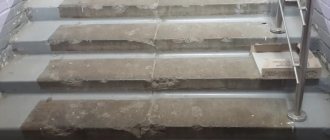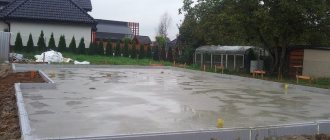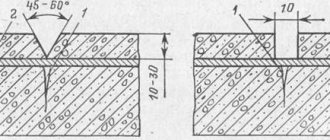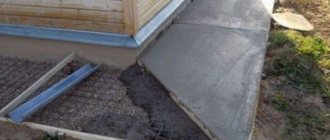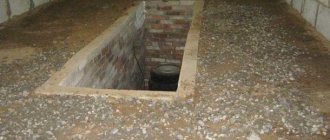Both older homes and new construction often require concrete repairs. Cracks may appear on it due to non-compliance with the filling technology, and at times due to old age. Almost all concrete and reinforced concrete structures shrink and compress when dry, and the property of concrete, such as low tensile strength, contributes to the appearance of defects.
Cracks in concrete occur due to non-compliance with pouring rules, and sometimes due to old age.
In addition, cracks in concrete appear:
- in case of mechanical damage to the material (accidents, excessive loads, vibrations, seismic activity, water wear);
- due to chemical damage (exposure to alkalis, salts and acids);
- due to physical processes (liquid leakage, temperature changes, erosion);
- from corrosion of reinforcement caused by carbonization, exposure to salts, humidity or carbon dioxide.
Regardless of the nature of the damage, they must be immediately eliminated, because serve as a source of further destruction of the concrete surface. There is no need to despair, all the work can be done with your own hands.
Repair compositions for concrete and their application
Before starting work, you need to visually inspect the damage and choose the correct repair method and select the necessary components. Repair compositions for concrete must be selected taking into account the operating conditions of concrete structures (weather conditions, frequent exposure to chemicals and detergents, temperature conditions). Experts recommend repairing concrete surfaces using mixtures from a domestic manufacturer, since their composition is developed taking into account the weather and climatic conditions of our country.
As a rule, the surface must be well moistened before applying the repair compound.
The quality and cost of repair mixtures depend on the presence of such properties as the ability to quickly thicken, high adhesiveness (the ability to firmly adhere to the surface), thixotropy (increasing the viscosity of a composition that does not experience mechanical stress).
High-quality repair mixtures for concrete contain polymer fiber and fine-grained aggregate, which make it possible to increase the thickness of the pouring layer to 100 mm, reduce consumption by up to 10%, and prevent further delamination. They have anti-corrosion properties for fittings and resistance to the aggressive influence of salts and sulfates.
All compositions for concrete repair are conventionally divided into 2 main categories: self-leveling (casting), used for horizontal concrete coverings, and thixotropic, suitable for vertical concrete walls and structures, ceiling surfaces without formwork.
Non-shrinkage concrete mixtures have an interesting feature - they are completely waterproofed thanks to specific additives added at the manufacturer. A monolithic structure poured in this way will last not 20-25 years, but at least 50.
Scheme for repairing concrete walls with repair mixtures.
It does not react to moisture and liquid and, in addition, has some elasticity and additional physical resistance to mechanical stress. Non-shrinkage concrete mixtures come in different types. Some are intended for construction, others are primarily for repair work. When applied, they adhere perfectly, and after hardening they do not differ from the original surface. It should be taken into account that repairs to large concrete areas (more than 5 m²) must be carried out using reinforcement, which further strengthens the structure. It is necessary to fasten the reinforcing mesh only with dowels, otherwise the result of the work may be unexpected.
Concrete structures experiencing significant loads may have an insufficiently strong surface (screeds, floor slabs and other monolithic structures). They can be strengthened with a deep penetration primer. During repairs, exposed reinforcement may be found, which must be treated with an anti-corrosion primer. Restoration of concrete in particularly critical areas must be carried out using special mixtures for quick repairs, which contain fiberglass, which improves the reinforcing characteristics of the composition.
Repairing deep cracks in concrete walls
Deep cracks especially clearly indicate damage to concrete. Maximum attention should be paid to those defects that are present on the facades of buildings. It must be remembered that stable and immobile cracks do not exist.
Even minor defects require prompt repairs. Otherwise, the degradation of the wall will increase , which will lead to critical results. If you fix the problem right away, it will later eliminate the need for complex and expensive restoration techniques. Two technologies are used for repairs: injection and sealing.
Principles of crack injection:
- holes are drilled along the defect in a checkerboard pattern and packers (injection tubes) are inserted;
- the repair compound is supplied through the tubes using pumps;
- to eliminate deep cracks, use concrete solutions mixed with cement and styrene-butadiene latex;
- Modern injection materials include polyurethane compositions and silicate-based solutions.
The injection composition is mixed in a 2:1 ratio and has a semi-liquid consistency
Sealing
The method is based on filling defects with compounds that ensure complete tightness. The damaged area is freed from dust and weak concrete, for which it is tapped with a chisel. The surface is moistened, a repair and sealing mixture is laid, for which a trowel or spatula is used. The working material is cement-sand mortars with plasticizers, polyurethane or epoxy sealing compounds.
How to make your own concrete repair composition?
If the area of damage is small, you can make a repair compound for concrete with your own hands. It includes:
Scheme of fillers for concrete mixture.
- Cement.
- Quartz sand.
- Fine gravel.
- Ground limestone.
- Polypropylene fiber.
- A complex of modifying additives, the composition of which depends on the characteristics of old concrete and operating conditions. These can be regulators of rheological properties, setting and hardening processes, special purpose regulators (frost resistance, moisture resistance, heat resistance), and multifunctional action.
- Water.
In the simplest version, the ratio of cement: sand: crushed stone: water is taken as 1: 2: 3: 0.8 (more water will be required when mixing by hand).
It is preferable to use a table of component ratios (Fig. 1), since to obtain concrete of a higher or lower grade, the ratio of all components must be changed. The dosage of modifying additives is indicated on the packaging and usually does not exceed 1% of the volume of cement.
Figure 1. Table of component ratios for concrete repair.
All dry ingredients must be mixed. After it, pour the required amount of clean water into an empty container and add the bulk composition to it, constantly stirring the mixture. To form a homogeneous mass, it is advisable to use a hammer drill with a mixer attachment. If concrete repairs are carried out in hot weather with low air humidity, the volume of water can be increased by 2-3%. If the temperature is below +5 degrees, then water at a temperature of 30-40 degrees is used to prepare the solution.
Mixing the dry mixture with water should be carried out for at least 4 minutes. The prepared solution should be used within 1 hour.
What problems might arise?
One of the problems that may arise at the stage of reconstruction of the floor is an incorrect inspection of the slab, and as a result, meaningless repairs. It happens that the cracks found at first glance seem harmless and builders easily seal them with sealant, mortar and other materials, but everything turns out to be more complicated. An unexamined defect actually results in negative consequences that lead to emergency conditions of the building.
For example, a longitudinal crack was discovered on the ceiling. It was not measured with a special device, and the strength of the concrete around the defect was not measured. It was decided to cover the crack with concrete solution.
After the repair, for several months everything met the standards, but six months later the crack appeared with renewed vigor and it had to be repaired with other materials and using other tools.
Another problem is the use of low-quality consumables that do not meet the stated standards. This can also include improper preparation of a solution for concreting a crack or incorrect technology for sealing the defect. All this leads to the fact that after some time the floor will have to be repaired again.
Preparing the base
Restoration of concrete should begin with high-quality preparation of the base. Initially, you need to remove dust, dirt, remnants of old paintwork, etc. from the surface. The damaged concrete layer must be beaten off and completely removed. The work area must be completely degreased; oil contamination must be removed using a solvent. Exposed reinforcement must be cleaned of corrosion.
The process of repairing concrete structures.
If repairs to concrete structures are carried out at above-zero temperatures, the surface is thoroughly moistened with a wet rag. You can use a hydro jetting unit. In cold weather there is no need to moisten the surface, but snow and ice must be removed using a torch.
Next, the moistened surface must be primed with a solution with a high adhesive content. The layer of solution should be 1-3 mm thick. Particular care must be taken to coat cracks and depressions with primer and to treat exposed reinforcement. This will not only improve adhesion, but also provide additional anti-corrosion protection. There is no need to prime the surface in cold weather.
Destruction of reinforced concrete: everything is under control
Destruction of concrete and reinforced concrete structures can occur due to a number of reasons:
- concrete fatigue (i.e. loss of structural integrity) due to long service life;
- increased shock loads;
- increase in payloads;
- mechanical damage;
- chemical or thermal effects;
- initially poor quality of raw materials and (or) violation of technological processes;
- exposure to weather conditions (sudden temperature changes, etc.);
- exposure to an aggressive environment (sea water).
How to apply repair solution?
The repair solution should be applied to the surface before the primer dries. First you need to fill the cracks. The main layer of repair mortar is applied without waiting for the mortar to completely set in the cracks. It is better to repair concrete manually in the following order:
Scheme for repairing concreting joints.
- First, a thin layer of the compound is applied with a small spatula over the entire repaired area, including exposed reinforcement, cracks and depressions.
- After this, a base layer up to 40 mm thick is immediately applied. It is convenient to do this with a rectangular trowel, with a handle located approximately in the center. Each portion of the solution should be pressed to the surface, and then quickly rubbed from the center to the edges.
The solution begins to harden within 20-40 minutes after application. At this point, the surface must be smoothed with a grater. If it is necessary to give the surface a shape (for example, to form a corner), this should be done at the same time. If concrete paths are being repaired, small stones can be embedded in the top layer to make them attractive and reduce slipping. In some cases, you can finish the paths with a trowel or roll a heavy metal pipe along them.
Filling cavities - strengthening walls
Depending on the purpose of the room and the location of the wall, concrete, cement mortars, dry repair mixtures, and gypsum plasters are used to repair potholes. Before repairing any pothole, the destroyed concrete is removed, dust and sludge are cleaned out. The surface is moistened and primed.
Sealing small holes:
- small defects indoors are filled with repair mortars or gypsum plasters;
- materials of this type are applied to a moistened surface;
- The mixture is thoroughly rubbed into the recess and smoothed.
Large Pothole Repair
Such defects can form as a result of the laying of communications, damaging force impacts, climatic and atmospheric influences.
The principle of work is as follows: at the site of the defect, including against the background of the lack of waterproofing protection, a formwork structure is built. The fittings are fixed inside. Next, pour a waterproofing high-strength concrete mixture. It is permissible to use cement mortars based on 3 parts sand, 1 part cement, water.
As a result, a frame is formed on the structure, characterized by water resistance and high strength. The implementation of such repairs takes relatively little time and gives a guaranteed result. The technology works both inside and outside buildings.
Caring for the restored coating
If repair work was carried out in warm weather, the restored area must be moistened and then covered with film or a wet thick cloth. You can use a special film-forming composition. Moisturizing the repaired surface increases strength, frost resistance, water resistance, and also prevents subsequent cracking of concrete.
In cold weather, rapid loss of moisture and heat from the repaired coating must be avoided. There is no need to moisten the surface; it must be covered with a moisture-proof material, and heat-insulating material or rags placed on top.

